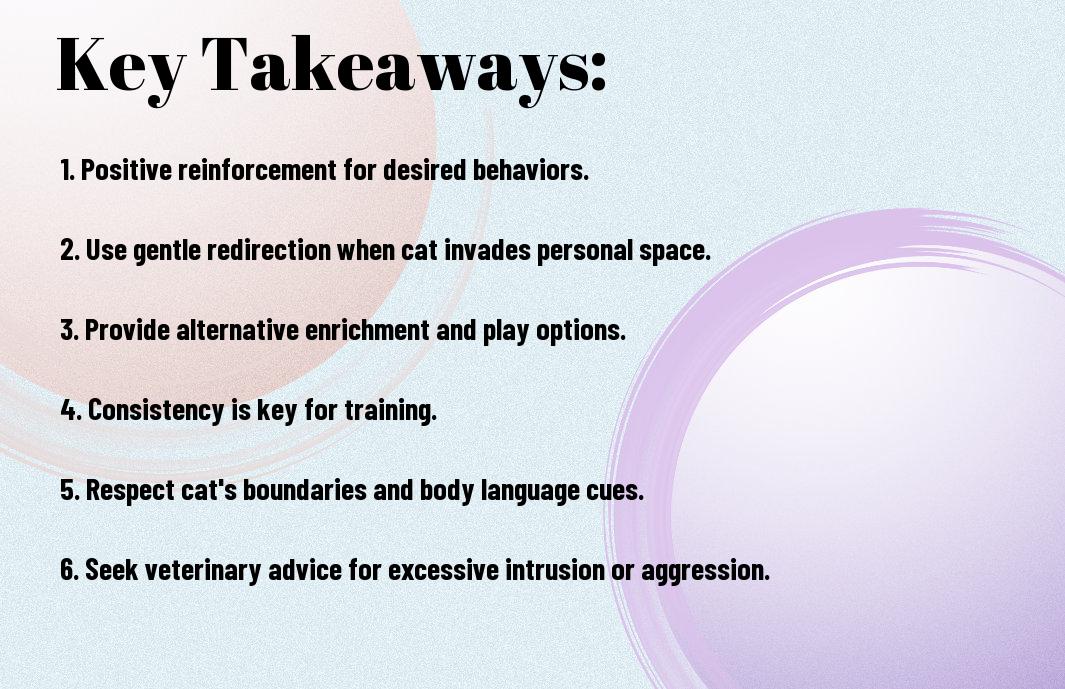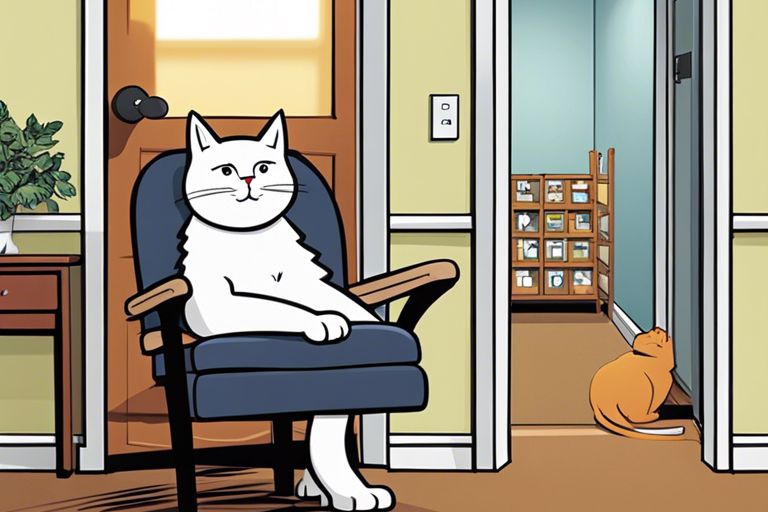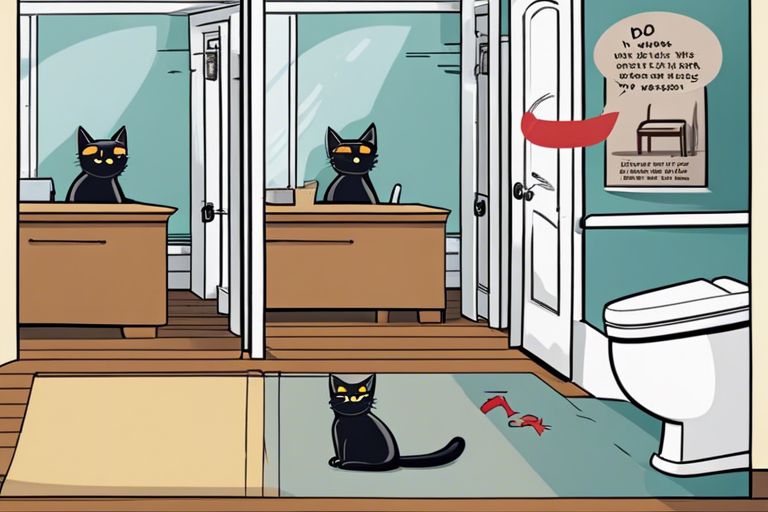Congratulations on taking the first step to improving your relationship with your feline friend. It can be frustrating when your cat constantly invades your personal space, but with some patience and consistency, you can teach them to be more respectful. In this blog post, you will learn some effective strategies and techniques to help you set boundaries and improve your cat’s behavior when it comes to personal space.
Key Takeaways:
- Establish Boundaries: Set clear boundaries for your cat’s behavior and consistently enforce them.
- Provide Alternative Spaces: Create designated areas for your cat to play and relax, redirecting their attention away from invading your personal space.
- Positive Reinforcement: Use positive reinforcement techniques, such as treats and praise, to encourage respectful behavior.
- Physical and Mental Stimulation: Ensure your cat is receiving enough exercise and mental stimulation to reduce the likelihood of them seeking out your personal space.
- Seek Professional Help: If your cat’s behavior persists despite your efforts, consider consulting with a veterinarian or animal behaviorist for additional guidance.


Establishing Boundaries with Your Cat
Obviously, teaching a cat to respect personal space can be a challenge, but it’s not impossible. Understanding your cat’s behavior and establishing clear boundaries is key to creating a harmonious living space for both of you.
The Role of Consistency in Training
Consistency is crucial when it comes to teaching your cat to respect personal space. If you allow your cat to invade your personal space sometimes and not others, it will only confuse them. That’s why it’s important to establish consistent rules and boundaries. If you don’t want your cat on the kitchen counter, for example, you must enforce this rule every time you catch them up there. Consistency will help your cat understand what behavior is acceptable and what is not.
Positive Reinforcement Techniques
When it comes to training your cat to respect personal space, positive reinforcement is key. Using rewards such as treats, toys, and praise can help encourage the behavior you want to see. For example, if your cat respects your personal space by not jumping on you while you’re working, be sure to reward them with a treat or positive reinforcement. Positive reinforcement techniques can help strengthen the bond between you and your cat while teaching them boundaries.
Creating a Respectful Environment
To ensure that your cat becomes more respectful of personal space, it’s important to create an environment that is conducive to establishing boundaries and fostering mutual respect between you and your pet. You can find more helpful tips on this topic in the article titled Cat And Their Personal Space: Respect The Boundaries!.
Designing a Cat-Friendly Space
When it comes to creating a respectful environment for your cat, it’s essential to design a space that is conducive to their needs while also respecting your personal boundaries. Provide your cat with designated areas such as cat trees, scratching posts, and cozy hideaways, so they have their own space to relax and play. This will help prevent them from encroaching on your personal space, while still allowing them to feel comfortable and at home in their environment.
Introducing Personal Space Rules to Your Cat
It’s important to establish clear personal space rules with your cat from the start. This can include setting boundaries around areas where they are not allowed to go, such as kitchen counters or tables. Consistently reinforce these rules by redirecting your cat to their designated areas, and rewarding them when they respect your boundaries. By doing so, you will communicate to your cat that certain spaces are off-limits, ultimately leading to a more respectful and harmonious coexistence.

Handling Setbacks and Challenges
After beginning the process of teaching your cat to respect personal space, you may encounter setbacks and challenges along the way. It’s important to stay patient and consistent in your approach, even when faced with obstacles.
Dealing with Attention-Seeking Behaviors
When your cat displays attention-seeking behaviors, such as nudging, pawing, or meowing for constant attention, it’s important to set boundaries. Ignoring these behaviors and only rewarding calm and respectful interactions can help your cat understand that demanding behavior will not be tolerated.
Addressing Aggression and Overstepping Boundaries
If your cat exhibits aggressive behaviors or consistently oversteps your personal boundaries, it’s crucial to address these issues immediately. Seek professional help from a veterinarian or animal behaviorist to assess the underlying causes of the behavior and develop a plan to address it. Do not ignore aggressive behaviors as they can pose a danger to you and others. Consistently reinforcing your personal boundaries and providing appropriate outlets for your cat’s energy can help address these issues.
Maintaining Progress and Respectful Behavior
However, once you have made progress in teaching your cat to respect personal space, it’s essential to maintain the respectful behavior and continue the training to reinforce good habits. Consistency in your approach and positive reinforcement will be key to ensuring that your cat continues to understand and respect your personal space.
Regular Training and Reinforcement
Continuing regular training sessions with your cat will help reinforce the importance of respecting personal space. Consistency is crucial, so make sure to set aside time each day to work on training and reinforce the boundaries you’ve established. Use positive reinforcement techniques such as treats, praise, and playtime to reward your cat for respecting your personal space.
Recognizing and Rewarding Respectful Behavior
Make a point to acknowledge and reward your cat when they exhibit respectful behavior. This could be as simple as giving them a treat when they give you space or allow you to have some alone time. By reinforcing these positive behaviors, you are reinforcing the importance of respecting personal space and helping to solidify the training you’ve done.
To wrap up
Teaching your cat to be more respectful of personal space is not an overnight process, but with patience and consistency, it is definitely possible. Remember to use positive reinforcement, such as treats and praise, to encourage good behavior and discourage unwanted behavior. It’s important to set clear boundaries and be consistent in enforcing them. With a little time and effort, your cat can learn to be more respectful of your personal space.
Frequently Asked Questions – Teaching Cats Personal Space
Q: How do I teach my cat to be more respectful of personal space?
A: First, establish clear boundaries by gently pushing your cat away and using verbal cues when they invade your personal space. Reinforce positive behavior by rewarding your cat with treats or affection when they respect your space. Additionally, provide your cat with plenty of designated areas, such as perches or cozy beds, where they can comfortably spend time without encroaching on your personal space.
Q: My cat is always in my face, how can I discourage this behavior?
A: If your cat is constantly invading your personal space, try redirecting their attention to a toy or scratching post when they get too close. You can also create a “safe zone” for yourself by using baby gates or other physical barriers to limit your cat’s access to certain areas of the house. Consistency is key – be firm in enforcing your personal space and reward your cat when they respect it.
Q: What should I do if my cat becomes aggressive when I try to establish personal space?
A: If your cat exhibits aggressive behavior, such as hissing, growling, or swatting, when you attempt to establish personal space, it’s important to seek guidance from a professional. Consult with a veterinarian or animal behaviorist to address the underlying causes of the aggression and develop a tailored plan to encourage respectful behavior. Avoid physically punishing or scolding your cat, as this can exacerbate aggression and damage your relationship with them.

Jayley, a devoted cat enthusiast, also writer for other cat blog as well. She aims to dedicated to providing comprehensive information, insights, and advice on everything you’d ever want to know about our whiskered companions.
